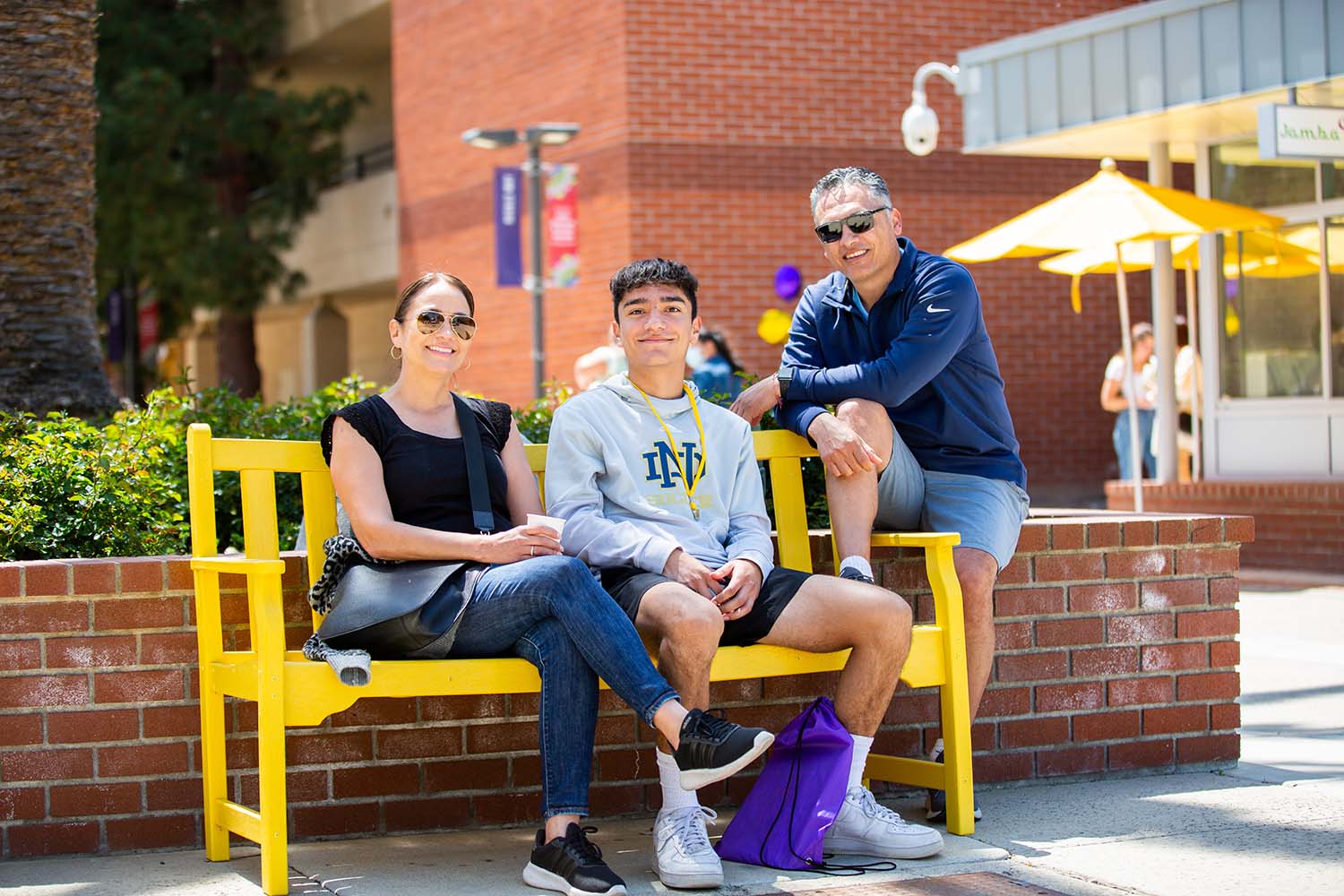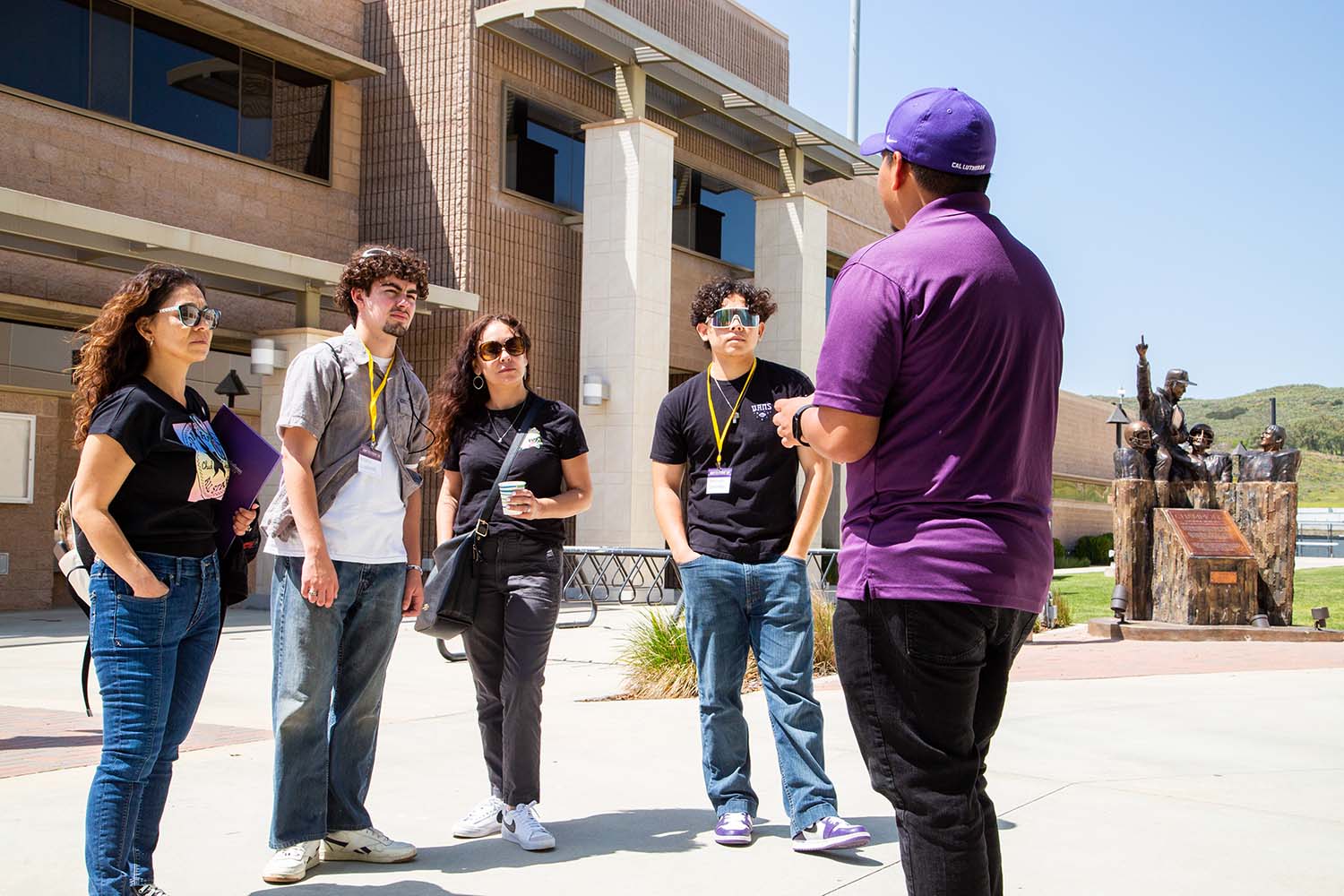How to Get Recruited for College Athletics
Tips to stand out in the recruitment process as a future star.
Score big with your target schools.
Do you dream of competing in college athletics? Our admissions and athletics experts have teamed up to help you learn how to get recruited as a student-athlete. Check out our tips to connect with coaches, navigate campus visits, and move forward with confidence.

In This Guide:
Navigating Campus Visits
Deciding Between Offers
Preparing for Recruitment
The first steps to getting recruited for college athletics begin years before college. By doing well in your academics and your sport early in high school, you can create opportunities to interact with college coaches in your sophomore and junior year, and then make your final decision as a senior.
Freshman and Sophomore Year
- Focus on grades and skills: Get good grades and work to improve in your sport
- Think about college: Start visualizing college goals (academics, location, sports)
- Get noticed (optional): You can start sending college coaches basic info (your stats, short video, etc.) to show your interest
- Coaches can contact you: After summer of sophomore year, college coaches can start reaching out — be sure to respond
Junior Year
- Reach out to coaches: Be proactive — don't just wait for coaches to find you
- Coaches may watch you play: Coaches may come to your games or watch videos
- Visit colleges (unofficially): You can visit campuses on your own and take tours
- Look for camps: Check out prospect or ID camps at your preferred colleges
- Possibly get offers: Some coaches might verbally offer you a spot, while others wait longer until you are more likely to accept
Senior Year
- Keep up your grades: Make sure you're on track to be eligible for college sports
- Apply to colleges: Apply to the schools you want to attend
- Visit colleges (officially): If you receive an official invitation, a common experience is to stay in the dorms and eat in the cafeteria
- Talk about money: Discuss scholarships and financial aid
- Stay eligible: Keep your grades up
Key factors for comparing colleges
- Size and location
- Campus culture
- Local community
- Majors and minors
- Internship opportunities
- Student research options
Look for a place you can be happy if sports goes poorly. It's good to have multiple paths to a successful college experience.
Key factors for comparing college athletics teams
- Coaching staff
- Team chemistry
- Gameday/training facilities
- Resources for athletic training
- Academic support for athletes
- Future paths after college
See where your skills are valued. What position would you play and how many of those positions are being recruited?
Important Resource
If you haven't already created an account with the NCAA Eligibility Center, plan to do this soon in order to compete at an NCAA school. It is recommended to register before your freshman year of high school.
Building Your Athletic Profile
It takes years of hard work and commitment to grow your athletic abilities for college.
Beyond high school athletics competition, you'll want to do year-round fitness training,
attend special events and tournaments, and consider club team involvement. With good
preparation, you'll be ready to showcase your skills to college coaches.
What stands out to coaches
- Distinguished physical attributes, skills and knowledge of the game
- Ability to fit into their system or fill a specific need
- Good grades (players must maintain eligibility)
- Ability to afford the costs of attending their particular college
- "WOW" factor — a unique quality that you offer
Tips for your highlight video reel
- Aim to grab the coach's attention within the first minute
- Visually highlight yourself in video editing software (shadow other players)
- Choose highlights from games against good competition
- Keep it under 2 minutes total — less is more

When should you use athletics recruiting websites?
You may encounter athletics recruitment platforms that seem enticing at first (i.e., they may offer a free account, let you create a profile, and add media). However, they aren't usually as effective as they may seem.
For a more effective strategy, focus on your top 10-15 colleges leading into your senior year of high school. Reach out to introduce yourself, personally and consistently. If you aren't able to build any serious relationships with coaches by the middle of your senior year of high school, then you might consider boosting your efforts through a recruitment website.
As you gear up to get recruited, remember to have fun. Keep your competitive spirit, but don’t get so caught up in attaining a perfect outcome that you burn yourself out before college even begins.
Falone Serna
Dean of Undergraduate Admission for Cal Lutheran
Connecting With Coaches
Reaching out to coaches may feel like uncharted territory, but following a few simple steps can make it easy. Start with an email that states some basic information about yourself, along with a link to your athletic profile or highlight video to show your skills in action. Indicate that you're looking forward to hearing back, and include contact info.
Tips for your initial email
- Send an email to each of the coaches on staff — especially anyone who has "Recruitment Coordinator" in their title
- Address the email using the coach's last name
- Include your name, graduation year, high school, position, and why you're interested in their specific program
- Mention something about academics or your intended major
- Ensure that your message is personalized to each coach/program
- Keep it concise — coaches are busy
- Don't be afraid to follow up multiple times, if there is no response

Got a reply to your initial email?
Success! Make sure you respond promptly to any of their follow-up messages.Sample email template
Subject Line: Prospective Student-Athlete - [Your Name, Graduation Year, and High School]
Dear Coach [Last Name],
I'm writing to express my strong interest in playing [Sport] at [College Name]. Here's a quick overview of my background:
- [Your Graduation Year] Graduate from [Your High School] in [Your City, State]
- Primary Position: [Your Primary Position]
- Why [College Name]? [Mention something specific about the college's program that interests you]
I believe my skills and dedication would be a great addition to your program. You can find more details in my [Athletic Profile/Highlight Video]: [Link to your profile or video]
Thank you for your time and consideration. I look forward to hearing from you.
Sincerely,
[Your Full Name]
[Your Phone Number]
Don't worry about having a big social media presence.
A targeted email is perfectly effective for reaching coaches.
Using bullet points will help make your email easier for coaches to read. Rather than writing lengthy paragraphs, offer a few details about yourself. The less fluff coaches have to read, the better.
Russell White
Head Men's Basketball Coach
California Lutheran University
Navigating Campus Visits
Both official and unofficial visits to colleges can offer valuable insights into the
college athlete experience. Through these opportunities, you can connect with coaches
and players, see the facilities firsthand, and ultimately determine the best fit for
your athletic and academic aspirations.
Official Visits
On official visits, the college covers certain expenses for you and your family (e.g., transportation, lodging and meals). These visits are typically limited in number by NCAA rules for Division I and II.
Official visits can occur during your junior and senior year. Receiving an invitation is seen as a strong indicator of a coach's interest in you.

Unofficial Visits
Unofficial visits are paid for by you and and your family, and there is no limit to the number of these visits that you can take.
These visits can occur at any time, based on when you and your family would like to tour college campuses. Try to notify coaches know about your planned unofficial visits in case you can connect.

What happens during campus visits?
Campus visits help you get a feel for the campus environment, team culture, and coaching style. Common activities include:
- Meeting with coaches
- Touring athletic facilities
- Exploring academic buildings
- Visiting team practices
- Attending games
- Interacting with current student-athletes
- Staying overnight in residence halls with current team members
- Eating at on-campus facilities
Top 10 Questions to Ask
Whether your visit is official or unofficial, you should ask good questions whenever you interact with a coach. Demonstrating interest in their specific program is crucial — you want to show that you have done some research or thoughtfully envisioned yourself at their school.
- What is your coaching philosophy and what are your expectations for athletes?
- How would you describe the team culture / what are the core values you emphasize?
- How do you see me potentially fitting into your program and what are your expectations for my development?
- What is the typical weekly schedule like during the season?
- What academic support services are available for student-athletes / how do you help us balance academics and athletics?
- What is the strength and conditioning program like, and what medical resources are available?
- Can you tell me about the current players and the team dynamic?
- What are the team's goals for the upcoming season and beyond?
- What factors determine playing time?
- What do you enjoy most about coaching at this institution?
Deciding Between Offers
In an ideal scenario, your hard work pays off with offers from multiple schools. But
even one offer is a big success that requires thoughtful deliberation — here are some
key considerations to help with the decision.
Clarify the distinguishing factors of each athletics program
By reflecting back on what you learned about each athletics program, you can give special attention to what matters most for you to be successful.
Team Culture
Interpersonal dynamics team-building activities, and general atmosphere
Coaching Staff
Leadership style, player development philosophy, and stability/turnover of staff
Playing Time
Potential for you to play an active role, especially during freshman year
Roster Size and Composition
Total number of players, players with your position/skills, and geographic diversity
Historical Legacy
Successful results from the team in the near and distant past
Future Goals
Big aspirations from the coach staff or players in the near future
Compare the key differences among NCAA divisions
Each division of competition represents a unique experience of collegiate competition — aim for the one that supports your holistic ambitions.
| NCAA Division I | NCAA Division II | NCAA Division III | |
|---|---|---|---|
| Level of Competition | Highest level of college athletics, often including athletes with an intent to play professionally | Still very competitive, with the overall intensity and time commitment slightly less than Division I | Competition is still serious and features dedicated athletes, with a focus on the overall college experience |
| Time Commitment | Requires the most significant time commitment from athletes, often year-round | Involves a substantial time commitment for athletes, though generally less than Division I | Demands a less intense time commitment, allowing more focus on academics, internships, extracurriculars, and other interests |
| Resources and Facilities | Typically boasts the most extensive and advanced athletic facilities and resources | Generally has good athletic facilities and resources, though less extensive than Division I | Usually has facilities and resources that focus on providing a good experience for the student-athletes without generating revenue |
| Academic Emphasis | Prioritizes athletics, while still requiring athletes to meet NCAA eligibility for academics | Focuses on athletics and academics, while still requiring athletes to meet NCAA eligibility for academics | Places the strongest emphasis on the academic experience: a "student-first, athlete-second" philosophy is strongly emphasized |
| Athletic Scholarships |
Gives generous athletic scholarships (which can cover tuition, fees, room/board, and books), as well as NIL funds (Name, Image, and Likeness) and revenue sharing |
Provides partial athletic scholarships, which may be supplemented with other forms of financial aid |
Financial aid is based on your grades, test scores, and financial need (the same as for non-athletes); private liberal arts colleges may have a significant cost, depending on merit and need |
| Overall | Professional-track competition, immense time commitment, substantial scholarships | High-level competition, significant time commitment, possibility of partial scholarships | Competitive environment with balanced priorities on athletics and academics for well-rounded experience |
Consider which school best suit your overall goals
Beyond life as a student-athlete, there are many nuances to each college experience. Check out these guides for a deeper dive.
Private vs. Public Universities
Choosing between a private and public university is a big decision. Which one offers your dream college experience?
5 Key Advantages of the Liberal Arts
Are the liberal arts still worth studying in today's world? If you want a future-proof college education — absolutely.
How to Choose a College Major
Your major will be a significant part of your overall academic experience. How do you pick the right one?
Want to learn more?
Complete this form and we'll add you to our email list.
We'll also keep you updated on admission deadlines and tell you more about our academics and campus life.




